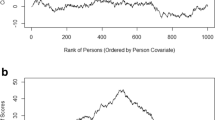Abstract
The Rasch model predicts that an individual's ability level is invariant over subtests of the total test, and thus, all subtests measure the same latent trait. A person test of this invariance hypothesis is discussed that is uniformly most powerful and standardized in the sense that the conditional distribution of the test statistic, given a particular level of ability, does not depend on the absolute value of the examinee's ability parameter. The test can be routinely performed by applying a computer program designed by and obtainable from the author. Finally, a suboptimal test is derived that is extremely easy to use, and an overall group test of the invariance hypothesis discussed. All tests considered do not rely on asymptotic approximations; hence, they may be applied when the test is of only moderate length and the group of examinees is small.
Similar content being viewed by others
References
Andersen, E. B. (1973). A goodness of fit test for the Rasch model.Psychometrika, 38, 123–140.
Andersen, E. B. (1980).Discrete statistical models with social science applications. Amsterdam: North-Holland.
Barndorff-Nielsen, O. (1978).Information and exponential families. New York: Wiley.
Borland International. (1987).Turbo Pascal 4.0 reference manual. Scotts Valley, CA: Author.
Cressie, N., & Holland, P. W. (1983). Characterizing the manifest probabilities of a latent trait model.Psychometrika, 48, 129–141.
Cronbach, L. J., & Gleser, G. C. (1965).Psychological tests and personnel decisions. Urbana, IL: University of Illinois Press.
Drasgow, F., Levine, M., & Williams, E. A. (1985). Appropriateness measurement with polychotomous item response models and standardized indices.British Journal of Mathematical and Statistical Psychology, 38, 67–80.
Drasgow, F., Levine, M. V., & McLaughlin, M. E. (1987). Detecting inappropriate test scores with optimal and practical appropriateness indices.Applied Psychological Measurement, 11, 59–79.
Gustafsson, J. E. (1980). Testing and obtaining the fit of data to the Rasch model.British Journal of Mathematical and Statistical Psychology, 33, 205–233.
Hambleton, R. K., & Swaminathan, H. (1985).Item response theory: Principles and applications. Boston, MA: Kluwer-Nijhoff.
Harnisch, D. L., & Linn, R. L. (1981). Analysis of item response patterns: Questionable data and dissimilar curriculum practices.Journal of Educational Measurement, 18, 133–146.
Hornke, L. F., Rettig, K., & Ages, C. (1988). Konstruktion eines Tests mit verbalen Analogien (CAT/A2) [Construction of a test with verbal analogies (CAT/A2)]. Unpublished manuscript. RWTH Aachen, Institut für Psychologie, Aachen.
Kelderman, H. (1984). Loglinear Rasch model tests.Psychometrika, 48, 223–245.
Klauer, K. C. (1986). Non-exponential families of distributions.Metrika, 33, 229–305.
Lehmann, E. (1970).Testing statistical hypotheses. New York: Wiley.
Levine, M. V., & Drasgow, F. (1983). Appropriateness measurement: Validity studies and variable ability models. In D. J. Weiss (Ed.),New horizons in testing (pp. 109–131). New York: Academic Press.
Levine, M. V., & Drasgow, F. (1988). Optimal appropriateness measurement.Psychometrika, 53, 161–176.
Lienert, G. A. (1973).Verteilungsfreie Methoden in der Biostatistik, Band I [Distribution-free methods in biometrics, Vol. 1]. Meisenhein am Glan: Anton Hein.
Molenaar, I., & Hoijtink, H. (1990). The many null distributions of person fit indices.Psychometrika, 55, 75–106.
Rost, J. (1982). An unconditional likelihood ratio for testing item homogeneity in the Rasch model.Education Research and Perspectives, 9, 7–17.
Rudner, L. M. (1983). Individual assessment accuracy.Journal of Educational Measurement, 20, 207–219.
Stoer, J. (1979).Einführung in die numerische Mathematik, Band I [Introduction to numerical mathematics, Vol. I]. Berlin: Springer.
Tatsuoka, K. K. (1984). Caution indices based on item response theory.Psychometrika, 49, 95–110.
Trabin, T. E., & Weiss, D. J. (1983). The person response curve: Fit of individuals to item response theory models. In D. J. Weiss (Ed.),New horizons in testing (pp. 83–108). New York: Academic Press.
Weiss, D. J. (1982). Improving measurement quality and efficiency with adaptive testing.Applied Psychological Measurement, 6, 473–492.
Witting, H. (1978).Mathematische Statistik [Mathematical statistics]. Stuttgart: Teubner.
Wright, B. D. (1977). Solving measurement problems with the Rasch model.Journal of Educational Measurement, 14, 97–115.
Author information
Authors and Affiliations
Rights and permissions
About this article
Cite this article
Klauer, K.C. An exact and optimal standardized person test for assessing consistency with the rasch model. Psychometrika 56, 213–228 (1991). https://doi.org/10.1007/BF02294459
Received:
Revised:
Issue Date:
DOI: https://doi.org/10.1007/BF02294459




